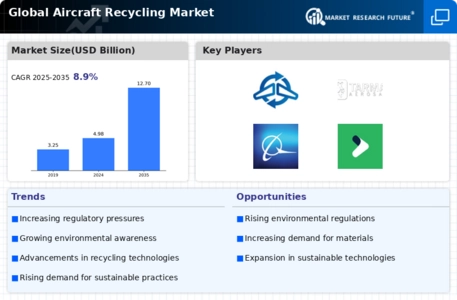Market Growth Projections
The Global Aircraft Recycling Market Industry is poised for substantial growth, with projections indicating an increase from 4.98 USD Billion in 2024 to 12.7 USD Billion by 2035. This growth trajectory reflects a compound annual growth rate of 8.9% from 2025 to 2035, driven by various factors including regulatory pressures, technological advancements, and rising consumer demand for sustainability. The market's expansion is likely to attract new entrants and investments, further enhancing competition and innovation within the industry. As stakeholders recognize the economic and environmental benefits of aircraft recycling, the market is expected to evolve dynamically, presenting opportunities for growth and development.
Global Fleet Retirement Trends
The Global Aircraft Recycling Market Industry is witnessing a surge in aircraft retirements, driven by the aging fleet and the need for modernization. As airlines phase out older aircraft, the demand for recycling services is expected to increase significantly. This trend is particularly pronounced in regions with large commercial fleets, where the retirement of older models creates a substantial volume of recyclable materials. The influx of retired aircraft is likely to provide a steady stream of business for recycling companies, thereby supporting the overall growth of the market. This trend aligns with the projected compound annual growth rate of 8.9% from 2025 to 2035.
Increasing Environmental Regulations
The Global Aircraft Recycling Market Industry is experiencing a notable shift due to increasing environmental regulations aimed at reducing carbon footprints. Governments worldwide are implementing stringent policies that mandate the recycling of aircraft materials, thereby promoting sustainable practices. For instance, the European Union has set ambitious targets for waste reduction, which directly influences the aviation sector. This regulatory environment encourages airlines to adopt recycling initiatives, contributing to the projected market growth from 4.98 USD Billion in 2024 to 12.7 USD Billion by 2035. As a result, compliance with these regulations is likely to drive demand for aircraft recycling services.
Economic Benefits of Aircraft Recycling
The economic benefits associated with aircraft recycling are becoming increasingly apparent within the Global Aircraft Recycling Market Industry. Recycling aircraft components can yield significant financial returns, as valuable materials can be recovered and resold. Airlines are recognizing that recycling not only mitigates disposal costs but also generates revenue through the sale of reclaimed materials. This financial incentive is likely to drive more airlines to engage in recycling initiatives, contributing to the market's expansion. As the industry evolves, the economic rationale for recycling is expected to strengthen, further supporting the anticipated growth from 4.98 USD Billion in 2024 to 12.7 USD Billion by 2035.
Rising Demand for Sustainable Practices
There is a growing awareness among consumers and stakeholders regarding the importance of sustainability in the aviation industry. The Global Aircraft Recycling Market Industry is responding to this demand by promoting the recycling of aircraft materials, which not only conserves resources but also reduces waste. Airlines are increasingly recognizing the potential benefits of sustainable practices, including cost savings and enhanced brand reputation. This trend is expected to contribute to a compound annual growth rate of 8.9% from 2025 to 2035, as more companies invest in recycling initiatives to align with consumer expectations and regulatory requirements.
Technological Advancements in Recycling Processes
Technological advancements are playing a crucial role in enhancing the efficiency of aircraft recycling processes. Innovations such as automated dismantling systems and advanced material recovery techniques are being integrated into the Global Aircraft Recycling Market Industry. These technologies not only streamline operations but also improve the recovery rates of valuable materials, such as aluminum and titanium. As a result, the market is likely to see increased participation from companies that leverage these advancements to optimize their recycling operations. This trend aligns with the projected growth trajectory, as the industry adapts to evolving technological landscapes.





